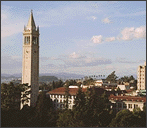

LINGUIST QUESTIONS STORY OF FIRST AMERICANS
A UC Berkeley linguist has turned the story of the first Americans upside down.
The conventional view is that Siberian immigrants journeyed to the New World some 12,000 years ago, after the last Ice Age.
But based on an analysis of indigenous languages throughout the New World, Johanna Nichols, professor of Slavic Languages & Literatures, concludes that the Siberians who settled in the interior and eastern parts of North America may have lived in Latin America first -- and for as many as 40,000 years.
Only along the West Coast, she said, do languages appear to represent recent immigration from Siberia. n
Nichols's research also shows that language diversity is so great in the New World that the approximately 150 existing, distinct, Native American language families would have required at least 35,000 years to develop.
Nichols also found that these indigenous languages are extraordinarily mixed. Normally, with recent migration, grammatical traits are regionally clumped. In the Americas, such traits are spread out evenly across the continent. She said this suggests a long period of diffusion, interaction and internal migration, with no outside influence.
"From the Sierras and the Andes mountains all the way to the Atlantic, American languages share distinctive, endemic features," said Nichols. "This indicates a common history of a people so ancient that we cannot hope to trace their linguistic descent."
"We can be sure that the Native Americans came into the New World a very long time ago," she added. "Their languages have scattered evenly throughout the hemisphere."
Nichols's work on indigenous American languages corresponds with genetic evidence suggesting a long human presence in the New World.
Archaeologists, on the other hand, have no direct evidence of early arrival. But new findings from the Monte Verde site in southern Chile have been dated at 12,500 years ago, a date so early it implies that humans were in the Americas prior to the onset of the last Ice Age, some 22,000 years ago. They apparently took refuge in the ice-free southern regions of the New World, moving northward as the ice receded.
![]()

[Table of Contents] [Berkeley Magazine Home] [UC Berkeley Home Page]
Copyright 1998, Regents of the University of California. All rights reserved.
Comments? E-mail ucbwww@pa.urel.berkeley.edu.